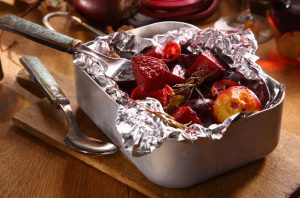
A salad is usually served at the beginning of a meal, but a salad can be a meal if you make it big enough. Eating a big healthy salad can also be a great way to get more fruits and veggies that are high in vitamins, minerals, and fiber.
The best part about making a big salad is that it’s so easy. Just pick your favorite fresh ingredients, pile them on a plate, top with a flavorful dressing and it’s ready.
Tips for Building a Tasty Meal-Sized Salad
Here’s how to make a big healthy salad, with ideas for great toppings.
Start with a bed of leafy greens. They’re low in calories and a good source of fiber. There are different varieties of lettuce, such as iceberg, leaf, spinach, escarole, romaine, or butter. The darker greens offer more nutrients than iceberg lettuce.
Add raw vegetables. Brightly colored vegetables have flavonoids, and the dark green vegetables are lowest in calories—about 20 calories per half-cup serving. Fresh green beans, snap peas, carrots, radishes, broccoli, cauliflower, zucchini, artichokes, avocados, tomatoes, and cucumbers are all healthy salad toppings.
Add fruits or berries. Blueberries, raspberries, blackberries, pomegranate arils, apple slices, and raisins can add vitamins, fiber, and antioxidants to your salad. One-half cup of apple slices has 30 calories, and one-half cup of berries has about 40 calories.
Add a little protein. A chopped or sliced hard-boiled egg is an excellent source of protein. You can add a serving of lean beef, cooked shrimp, tuna, chicken breast, or strips of cheese. Watch your portion size and avoid fried meats like chicken strips or battered and fried shrimp. A quarter cup of chopped chicken meat or one egg will add 75 calories. Half a can of tuna adds about 80 calories. Two ounces of cubed or shredded mozzarella or cheddar cheese may add up to 200 calories.
Sprinkle a few nuts. Walnuts, pecans, almonds, or cashews add a nice crunch. Just a few nuts will do, as a one-eighth cup of nuts adds about 90 calories. Walnuts are an excellent source of omega-3 fatty acids, and all nuts add protein and heart-healthy polyunsaturated and monounsaturated fatty acids.
Finish with salad dressing. One tablespoon of regular commercial salad dressing adds 50 to 80 calories. Low-fat and reduced-calorie dressings are available, or you can top your salad with freshly squeezed lemon or lime juice.
Healthy, Low-Calorie Salad Recipe
Here’s a big healthy salad that has lots of vitamins, antioxidants, phytochemicals, and fiber, plus it’s low in calories (about 400). And best of all, it’s simply delicious:
* 2 cups of green leaf lettuce
* 1/4 cup raw green beans
* 1/4 cup snap peas
* 1/4 cup chopped tomato
* 1/4 cup sliced carrots
* 1/4 cup apple slices
* 1/4 cup blueberries
* 1/4 cup chopped chicken breast
* 1 chopped hard-boiled egg
* 1 ounce of shredded mozzarella cheese
* 1/8 cup walnut pieces
Top the salad with juice squeezed from a few wedges of lemon or lime. Or, if you prefer, use a light commercial salad dressing, or a bit of oil and vinegar. Just remember, dressing and oil add extra calories.
Serve your salad with a slice or two of fresh whole-grain bread and a tall glass of sparkling water with a slice of lemon or lime.
From a different perspective
Nine out of 10 times the salads you order are in no way healthier than the other dishes on the menu.
If you are health conscious, you may opt for a bowl of salad as if by instinct when dining out.
But is the choice you are making really healthy and your best calorie bet? The answer may be no.
That’s because a few ingredients put together and named salad on the menu doesn’t make it healthy. Though people think they can never go wrong with salads, the bad news is they can.
“Truth be told. Nine out of 10 times the salads you order are in no way healthier than their opposite numbers on the menu. You would be surprised to know the number of calories the fancy additives like croutons, canned fruits, thick creamy dressings add to it, which absolutely throws the idea of clean eating down the tubes,” said Swati Sodhi, senior nutrition consultant with SQUATS, an online consultation platform for health and fitness.
NOT A MEAL REPLACEMENT
Manasa Rajan, coach at Cure.fit, a health and fitness startup, said: “More people trying salads as their healthier go-to meals is a significantly positive trend. With eating vegetables that are raw and lightly cooked, we have a better understanding of what we eat and how it impacts our health.” She added that salads in general nowadays have more of a health focus rather than a purely culinary one.
Salads are recommended to add fibre and micronutrients to our diet. However, one must not replace a meal with only vegetable salads as they lack protein. Many fall prey to fad diets and replace their whole meals with vegetable salads.
“In the long term, if protein intake is not taken care of, one can become deficient in protein which is very essential for all our regulatory functions. So, a part of the meal can consist of salads but not the whole meal on a regular basis,” said Shalini Arvind, chief dietician, Fortis Hospital, Bengaluru.
According to Sodhi, “most people don’t realise that our body needs a certain number of calories to perform its functions efficiently. Most beginners, who want to start a diet, start eating salads for all the meals of the day, thinking that they need to eat less to lose weight. However, eating less doesn’t mean starving yourself. Just eating lettuce with a blob of creamy dressing and some cherry tomatoes is not the right thing to do. In fact, this could lead to slower metabolism, which in turn can make you gain more weight in the long run.”
GOING WRONG
Salads, at their basic best, are a bowl full of veggies such as greens, tomatoes, peppers, cucumbers and carrots. But who wants only a plain salad? Not many, and they zero in on something fancy.
A unique salad on the menu (doesn’t necessary imply healthy) could add croutons (stale fried bread), canned fruits (sugar syrup laden), creamy dressings (mostly these contain more calories than the entire salad), fried noodles or loads of cheese (calorie dense). “These yummy little culprits can turn your healthy meal into a fiesta of calorie overload. Make sure you are mindful of what you are ordering and if possible, it is always better to customise your salads,” advised Sodhi.
According to Rajan, “the ‘dressings’ in the salad, which are seldom questioned, contain a lot of oil, salt, sodium, additives and preservatives, which can make the seemingly healthy salad calorie dense and full of unhealthy preservatives.”
Nowadays, more and more food joints are luring people with a variety of salads that are not actually healthy. To make the salads tasty and tempting, they decorate them with highcalorie toppings such as thick cream, cheese or mayonnaise. Thus, the whole idea of consuming less calories is invalid in this case. A healthy salad should include fresh and crunchy vegetables topped with a few spices and low-calorie oil, explained Arvind.
“One should consider the calorie content while eating salads. (For example) a salad with fried chicken dressed with mayonnaise is not healthy, while a bowl of salad filled with colourful vegetables, fruits or mixed greens like spinach, cabbage, broccoli and bell peppers along with carrots, baby tomatoes, beans and grilled chicken, fish or any meat cooked in healthy oil is a preferred bowl of salad,” she said.
Rajan too said that while trying to restrict calories to lose weight, it is very important to eat nutrient-dense foods with fibre, complex carbs, quality protein and healthy fats. Very low-nutrition and low-calorie lettuce-filled salads or thick mayonnaise-filled dressings wouldn’t serve any health goals positively.
Now the hygiene part. “If you are buying a readymade salad from eateries, you should be double careful about its hygiene standards. Salads can harbour a good number of microbes and can be a source of infection if they are not cooked properly and are ready to eat. One should make sure that the product bought is clean and it follows all the safety measures,” Arvind said.
SALAD SENSE
– A diet-friendly salad should be a well-balanced combination of carbohydrates, fats and proteins
– Choose vinaigrette-based dressings for your salads as opposed to the creamy ones
– Try adding more of dark green veggies
– Choose a grilled, steamed or sautéed portion of protein for your salad instead of a fried one, be it chicken, fish, tofu, paneer or eggs
– Don’t forget to add good fats. Choose from avocados, nuts or different kinds of seeds like chia and sunflower
– You can also add a cup of fruit, pasta, potatoes or quinoa for a complete meal
– Say no to creamy dressings, candied fruits or nuts, cold cuts and croutons in your salads
– Moderation and portion control are an absolute must
– Food items like avocados or cheese are calories dense, so exercise moderation.
MAKE A HEALTHY ONE
Nutritionally, to make salads healthy, one must avoid adding excessive fat as the intention itself is to reduce excess calories. One can add sprouts and legumes to add the protein factor to it. Try to avoid adding too much of salt for taste. Dried herbs, onion or garlic powder, pepper powder, coriander leaves and lemon juice can be added instead of salt to make it healthier, said Arvind.
For a filling salad, add small amounts of low-fat cheese or lean protein like grilled chicken, shrimp or hard-cooked egg. Avoid too much drenching — olive oil and vinegar should be added in moderation to maintain the nutrients of the salad. Crunchy chicken or fried noodles and sauces should be avoided. Make sure the fruits and vegetables, especially the green leafy vegetables, are properly washed before using, Arvind added.
KNOW THE BALANCE
Sodhi said: “Choose salads with raw or roasted ingredients; sometimes sautéed vegetables along with the dressings contain excess oil, pumping up the calories. Choose oil-free, chemical-free, sugar-free or balsamic dressings over oily, creamy, heavy dressings.”
Quality ingredients and a good mix of complex carbohydrates, protein and essential omega fatty acids are essential. Use greens like arugula and spinach for their antioxidant benefits, colourful vegetables like beets, pumpkin, eggplants, tomatoes, nuts and seeds for their healthy fats and bright fruits like figs, berries, citrus for the phytonutrients. Whole grains and lentils are a bonus, she said.
Checkout our top salad ideas below
Want to test yourself at home at 20% off? click here
(USE slayfitness20 TO GET 20% OFF)
Sources Economic times, Very well fit








